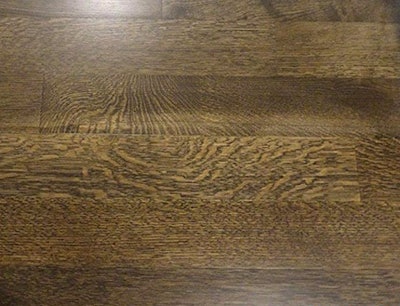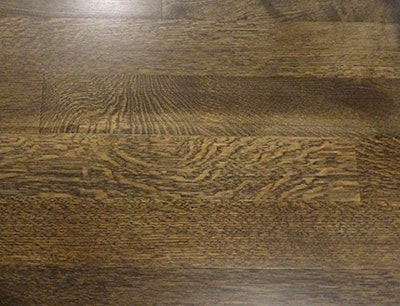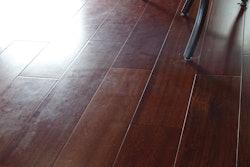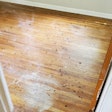
 The homeowners were unhappy with the appearance of this stain.
The homeowners were unhappy with the appearance of this stain.
The Issue
The homeowners purchased 4-inch unfinished quartersawn white oak to be installed, stained and finished in their new home. An interior designer provided color samples to match the flooring with the cabinets. During the color sample process, the designer was unhappy with the color variance on the flooring planks compared with the uniform color of the cabinet. The flooring contractor told the designer that the wood grain and stain application on the floor is different, thus the color variance. The designer said she would contact the cabinet company to furnish enough of the cabinet stain to use on the wood floor. The wood floor contractor told the designer there would be no guarantee regarding how uniform the color would be when completed, but he used the cabinet stain. Afterwards the homeowners were unhappy with the stain, and they contacted an inspector.
Roy: The Inspector's Observations
Although the sanding was top-quality and the finish evenly applied, I found several areas where the stain had inconsistencies, including light spots, lap lines across multiple planks and stain stop marks. The flooring contractor was present during the inspection and said he told the designer the cabinet stain furnished was a fast-dry product that was hard to control and could have some variances. I asked the flooring contractor to provide a copy of the release of liability signed, but the flooring contractor said it was only a verbal agreement. My conclusion was that the staining of the wood floor did not comply with the industry standards.
Blake: The Attorney's Analysis
Wood flooring pros are often faced with a dilemma similar to the one described above, where the customer requests that the flooring pro do something that is not recommended. While the pro in our example did apparently make the customer aware there could be issues, his mistake was failing to get a written waiver or release signed by the customer. The customer should be required to sign a document stating that the pro has explained the potential issues with the request and that he is not responsible if it turns out poorly. (With or without a waiver, it's best to test an unfamiliar product before using it on a job site.) In our current scenario, by applying the cabinet stain to the floor, the flooring pro has agreed to complete the floor correctly. That fact, coupled with the inspector finding some workmanship issues, means he is on the hook to correct the issues and refinish the floor to industry standards. As they say, no good deed goes unpunished.

































